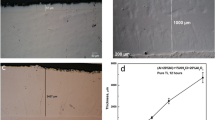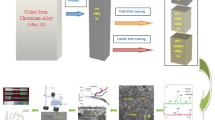Abstract
Tungsten Inert Gas (TIG) process has been employed to produce surface alloyed tracks on preplaced CP-Ti substrate with Si to improve wear resistance. Uniform alloyed tracks with hypo eutectic binary Ti–Si compositions have been achieved using preplaced layers with Si amounts of up to 40 at.%. Si content of the TIG alloyed tracks was found to be affected by the TIG heat input and Si amount of the preplaced layer. The microstructures of the surface alloyed tracks showed phases of primary α-Ti in dendrites and eutectic lamellas of α-Ti and Ti5Si3 within the interdendritic regions using optical and scanning electron microscopy, X-ray diffractometry, and energy dispersive spectroscopy. Finer dendrites were found at lower heat input. A maximum micro hardness value of 750 HV was found in the surface alloyed track, which is ~4 to 5 times of that of the substrate material (180 HV). Pin-on-disk wear tests exhibited the better performance of the surface alloyed tracks than the untreated material which is attributed to the presence of Ti5Si3 intermetallic compound in the microstructure.














Similar content being viewed by others
References
ASM handbook, vol 2-properties and selection: nonferrous alloys and special—purpose materials. ASM International (1990)
Handbook ASM vol 18—friction, lubrication and wear technology. ASM International (1990)
Budinski KG (1991) Wear 151:203. doi:https://doi.org/10.1016/0043-1648(91)90249-T
Bi Q, Matthews A (2003) Surf Coat Technol 163–164:597. doi:https://doi.org/10.1016/S0257-8972(02)00630-8
Pfohl C, Rie KT (1999) Surf Coat Technol 116–119:911. doi:https://doi.org/10.1016/S0257-8972(99)00141-3
Lifang X, Xinxin M, Yue S (2000) Wear 246(1–2):40. doi:https://doi.org/10.1016/S0043-1648(00)00444-0
Liang W, Zao XG (2001) Scr Mater 44:1049–1054. doi:https://doi.org/10.1016/S1359-6462(01)00675-3
Euh K, Lee J, Lee S, Koo Y, Kim NJ (2001) Scr Mater 45:1–6. doi:https://doi.org/10.1016/S1359-6462(01)00981-2
Oh J, Lee S (2004) Surf Coat Technol 179:340. doi:https://doi.org/10.1016/S0257-8972(03)00811-9
Mridha S, Baker TN (1997) J Mater Process Technol 63:432
Tiam YS, Chen CZ, Chen LX, Huo QH (2006) Mater Lett 60:109. doi:https://doi.org/10.1016/j.matlet.2005.07.082
Dutta Majumdar J, Mordike BL, Manna I (2000) Wear 242:18. doi:https://doi.org/10.1016/S0043-1648(00)00363-X
Dutta Majumdar J, Weisheit A, Mordike BL, Manna I (1999) Mater Sci Eng A 266:123. doi:https://doi.org/10.1016/S0921-5093(99)00045-3
Wenbin D, Haiyan J, Xiaoqin Z, Dehui L, Shoushan Y (2007) J Alloy Compd 429:233. doi:https://doi.org/10.1016/j.jallcom.2006.03.083
Baytoz S, Uttran M, Mustafa M (2005) Appl Surf Sci 252:1313. doi:https://doi.org/10.1016/j.apsusc.2005.02.088
Mridha S (2005) J Mater Process Technol 168:471–477. doi:https://doi.org/10.1016/j.jmatprotec.2005.02.247
Mridha S, Ong HS, Poh LS, Cheang P (2001) J Mater Process Technol 113:516. doi:https://doi.org/10.1016/S0924-0136(01)00609-4
Anthony TR, Cline HE (1977) J Appl Phys 48(9):3888. doi:https://doi.org/10.1063/1.324260
Chade T, Mazumder J (1983) Metall Trans 14B:181
Easterling KE (1992) Introduction to the physical metallurgy welding. Butterworth-Heinemann, London
Flower HM, Swann PR, West DRF (1972) J Mater Sci 7:929. doi:https://doi.org/10.1007/BF00550440
Kurz W, Fisher DJ (1984) Fundamentals of solidification. Trans Tech Pub., Netherlands, p 71
Chumbley LS, Ohles MA, Fraser HL (1986) In: Froes FH (ed) Titanium rapid solidification technology. TMS-AIME, Warrendale, PA, p 211
Abboud JH, West DRF (1991) Surf Eng 7(2):159
Massalski TB, Okamoto H, Subramanian PR, Pkacparzak L (1990) Binary alloy phase diagram. ASM International, Material Park, OH
Fasasi AY, Roy SK, Galerie A, Pons M, Caillet M (1992) Mater Lett 13:204
Bumps ES, Kessler HD, Hansen M (1953) Trans ASM 45:1008
Author information
Authors and Affiliations
Corresponding author
Rights and permissions
About this article
Cite this article
Hajbagheri, F.A., Kashani Bozorg, S.F. & Amadeh, A.A. Microstructure and wear assessment of TIG surface alloying of CP-titanium with silicon. J Mater Sci 43, 5720–5727 (2008). https://doi.org/10.1007/s10853-008-2890-9
Received:
Accepted:
Published:
Issue Date:
DOI: https://doi.org/10.1007/s10853-008-2890-9




